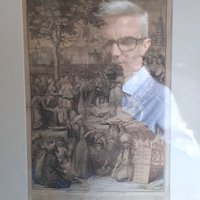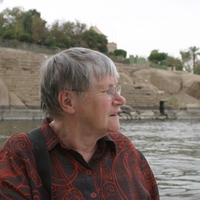Papers and edited volumes by Olivier Delouis
Sacris Erudiri, 2020
The Constitutiones asceticae or Ascetic Constitutions ( CPG 2895) are apocryphal
but attributed ... more The Constitutiones asceticae or Ascetic Constitutions ( CPG 2895) are apocryphal
but attributed to Basil of Caesarea in all manuscripts containing his
Asceticon Magnum or Great Asceticon (CPG 2875). The abbot Theodore the
Stoudite (759-826), aware of the controversy, wrote a scholion to defend Basil’s
authorship. In this paper, we present the first critical edition of Theodore’s
scholion, with an English translation and a commentary.
dans O. Delouis et K. Smyrlis (éd.), Lire les archives de l'Athos (Travaux et Mémoires 23/2), p. ix-xix, Paris
dans O. Delouis et K. Smyrlis (éd.), Lire les archives de l'Athos (Travaux et Mémoires 23/2), p. 507-526, Paris
This paper contains the publication of the account of the travel of Mgr Louis Petit (1868–1927) o... more This paper contains the publication of the account of the travel of Mgr Louis Petit (1868–1927) on the Holy Mountain from May to July 1921, written some years later by his secretary, the Belgian Jules Pector (1890–1973), an Assumptionist friar. Pector, armed with his Franco-Greek typewriter, worked from 1911 to 1927 for the Byzantinist Petit, a tireless editor of several volumes of Athonite archives that appeared as supplements of the Russian journal Vizantijskij vremennik. Using simple language, Pector reports the vicissitudes of life on the Holy Mountain, drawing with humor some vivid portraits of the monks they met there.

dans O. Delouis et K. Smyrlis (éd.), Lire les archives de l'Athos (Travaux et Mémoires 23/2), p. 341-356, Paris, 2019
For monasteries, gifts and bequests were God’s blessing. For the donor, the gift was supposed to ... more For monasteries, gifts and bequests were God’s blessing. For the donor, the gift was supposed to bring forgiveness for his sins and salvation for his soul, thanks to the monks’ perpetual prayers. For the donor’s family, however, the situation was often different. They might see such donations as depriving them of a part or even of all of the properties they stood to inherit by law. Conflicts triggered by pious donations hardly appear in our sources, with the notable exception of documents and monastic rules (typika). The documents preserved on Mount Athos and certain typika allow us to see the troubles individual piety and generosity sometimes caused. This paper presents some examples drawn from the Athonite archives and reviews the solutions the donors found to counter the greatest threat to their gifts: the expectations of their own family.

Les mobilités monastiques en Orient et en Occident, de l’Antiquité tardive au Moyen Âge (IVe-XVe siècles), Rome (Collection de l’École française de Rome, 558), 2019
This volume aims at studying a paradoxical feature of the monastic life, that of the mobility of ... more This volume aims at studying a paradoxical feature of the monastic life, that of the mobility of monks, yet constrained by various rules and norms, from the very beginning of their institutional history, to closure and stabilitas loci. During a long Middle Ages, going from the 4th to the 15th century, evidences of movements, circulations, exchanges and monastic influences reflect a very concrete reality, and address the essential needs of the monks' life in its economic, administrative, intellectuals or religious aspects. As a multifacetted phenomenom, it seemed appropriate to have contextualized case-studies to perceive, in each example, the tension that may arise from the very notion of travel for one who, due to his vocation, is supposed to have given up any move outside his cloister. The papers address the question of mobility - condemned, tolerated or encouraged - as a not secondary but essential factor in the definition and construction of monasticism in the East as in the West. This volume contains 23 contributions presented during two scientific meetings held at the French School of Rome in 2014 and at the University of Vienna in 2016, as part of a program entitled “Monks around the Mediterranean. Contacts, exchanges, influences between East and West, from Late Antiquity to the Middle Ages (4th-15th century)”.

O. Delouis et M. Mossakowska-Gaubert (éd.), La vie quotidienne des moines en Orient et en Occident (IVe-Xe siècle). Volume II, Questions transversales (Bibliothèque d’étude 170), viii+494 p., Le Caire, 2019
With this book, the joint research programme Everyday Life in Eastern and Western Monasticisms ... more With this book, the joint research programme Everyday Life in Eastern and Western Monasticisms (4th-10th century AD) reaches its end. A first volume presented the variety of sources to study daily monastic life for the first centuries, in geographical order. During a second colloquium held in Paris, a comparative perspective was applied to six transversal topics: monastic landscape, the monk’s body, prayer, sociologies, productive economy, creation and dissemination of monastic rules. The present volume gathers twenty-two articles questioning these issues common to Egyptian, Nubian, Syro-Palestinian, Byzantine, North African, Visigothic, Italian, Frankish and Germanic, Anglo-Saxon or Irish monks. Although the approaches are manyfold, we have maintained our ambition to consider all forms of monastic life. Therefore, it was possible to grasp monasticism as a diverse phenomenon, which has been shaped by various environments. If daily monastic life is repetitive and does not always present salient features, it nonetheless mirrors the history of societies within which monks have settled down.

dans S. Brodbeck, A.-O. Poilpré et M. Stavrou (éd.), Visibilité et présence de l’image dans l’espace ecclésial: Byzance et Moyen Âge occidental (Byzantina Sorbonensia 30), p. 151‑170, Paris, 2019
L’iconologie de Théodore Stoudite (759-826) est entièrement fondée sur le paradoxe chrétien du Di... more L’iconologie de Théodore Stoudite (759-826) est entièrement fondée sur le paradoxe chrétien du Dieu incarné, rendu visible aux hommes. L’icône, ce « signe le plus évident de l’économie divine », se trouva placée, par une circonstance historique extérieure – à savoir l’iconoclasme des empereurs byzantins –, au cœur de sa vie d’higoumène, d’homme d’action, de poète, d’hagiographe et de théologien. On le dit moins technicien que son contemporain Nicéphore, patriarche de Constantinople, mais il fut tout comme lui un logicien imparable, qui plus est accessible. Innovant quand il investit l’icône d’une dimension christologique – elle est présence de l’hypostase –, implacable quand il démontre par la circonscriptibilité du Christ que l’icône est une preuve non pas accessoire mais exigée de l’Incarnation, fondamental encore pour avoir distingué dans la proskynèse une vénération double, l’une de relation, pour l’image artificielle, et l’autre d’adoration, pour le seul prototype, l’higoumène du monastère de Stoudios à Constantinople a marqué sans aucun doute l’histoire intellectuelle de la représentation.
Pour autant, Théodore est un homme pratique revendiquant son inscription dans le temps – même s’il doit s’en plaindre. L’homme concret dont il connaît le visage et l’âme pour manier chaque jour le troupeau de ses moines, l’icône matérielle qu’il voit en scène, qu’il décrit et fait parfois parler dans ses œuvres, les métaphores, telle celle récurrente du sceau et son style si coloré, trépident et persuasif, façonné dans les catéchèses monastiques et dont il ne se déprend jamais vraiment, sont autant de traits qui invitent à mettre en relation la théologie de Théodore et son expérience. On en appellera donc ici au contexte visuel et sensible des écrits de Théodore, théoricien et produit de la tradition de l’image à Byzance.
dans M. Re, C. Rognoni et F. Paola Vuturo (éd.), Byzantino-sicula 7. Ritrovare Bisanzio : atti delle Giornate di studio sulla civiltà bizantina in Italia meridionale e nei Balcani dedicate alla memoria di André Guillou : Palermo 26-28 maggio 2016, p. 179-195, Palerme, 2019

avec A. Peters-Custot, dans O. Delouis, M. Mossakowska-Gaubert et A. Peters-Custot (éd.), Le voyage de Rome dans la fabrique des saints moines byzantins, dans Les mobilités monastiques en Orient et en Occident… (Collection de l’École française de Rome 558), p. 311-336, Rome, 2019
Both the Church and civil authorities have always been fighting, since the first centuries, to ba... more Both the Church and civil authorities have always been fighting, since the first centuries, to ban monks’ mobilities, to impose on them a geographical stability and later a strict enclosure within their monasteries. After having recalled the nature of these prohibitions in canon and civil law, and assessed the relative moderation of monastic literature, closer to reality, we will focus on monks’ pilgrimage: was it a valid exemption to the stabilitas loci? The city of Rome, which was a favorite destination for Byzantine monks, will provide a striking example. Many Byzantine monks, between the eighth and eleventh centuries, visited this apostolic city and patriarchate of the West, in order to offer their devotions, seek political support, and also follow a path of holiness. Byzantine hagiography of monks coming from the East and from southern Italy will be our main source, that will allow us to examine the role of this singular journey and its evolution over time for the achievement of monastic sanctity.
Le mont Athos, jardin de Byzance (2018)
L'Histoire - Les Collections, 2018

dans B. Caseau, V. Prigent et A. Sopracasa (éd.), Οὗ δῶρόν εἰμι τὰς γραφὰς βλέπων νόει. Mélanges Jean-Claude Cheynet (Travaux et Mémoires 21/1), Paris 2017, p. 67‑108.
The Canonical collection of the hieromonk Macarius, formerly preserved in the library of Nikolsb... more The Canonical collection of the hieromonk Macarius, formerly preserved in the library of Nikolsburg in Moravia—now Mikulov, Czech Republic—disappeared after the sale of Prince Alexander von Dietrichstein’s library in Lucerne in 1933. Discovered by chance in 2012 in France (Orléans), it is studied here thoroughly for the first time. Now dated from 1525/26, the Collection offers a new thematic classification of Matthew Blastares’s Syntagma canonum (14th c.), enriched with various other texts. The study consists of three parts: a codicological description of the manuscript with a detailed analysis of its content, the narrative of its modern history, and an assessment of the importance of Macarius’s work compared to similar canonical collections. After this discovery, the manuscript was bought by the Bibliothèque nationale de France, and is now the Parisinus Suppl. gr. 1394.
dans Noctes Petropolitanae. Материалы конференции, посвященной столетию со дня кончины А. И. Пападопуло-Керамевса (1856-1912) [Actes de la conférence dédiée au centenaire de la mort d’A. I. Papadopoulos-Kérameus (1856-1912)], p. 19-27, Saint-Pétersburg, 2016
Материалы конференции, посвященной столетию со дня кончины А. И. Пападопуло-Керамевса (1856-1912)... more Материалы конференции, посвященной столетию со дня кончины А. И. Пападопуло-Керамевса (1856-1912) Нестор-История Санкт-Петербург 2016 УДК 94(37) ББК 63.3
dans O. Delouis, S. Métivier et P. Pagès (éd.), Le saint, le moine et le paysan (Byzantina sorbonensia 29), Paris 2016, p. 119‑138.
dans D. Dželebdžić et B. Miljković (éd.), ΠΕΡΙΒΟΛΟΣ. Mélanges offerts à Mirjana Živojinović (Institut d’études byzantines de l’Académie serbe des sciences et des arts. Etudes 44/1), Belgrade 2015, p. 227‑250.
An unpublished document of 1321 from the Karakala/Karakallou archive on Mount Athos documents the... more An unpublished document of 1321 from the Karakala/Karakallou archive on Mount Athos documents the little-known history of this monastery (here summarized with all extant Byzantine documents) and tells us about the Kabasilas family and its properties located in Chalkidiki, near Thessaloniki [published before C. Pavlikianov's subsequent edition].
dans O. Delouis et M. Mossakowska-Gaubert (éd.), La vie quotidienne des moines en Orient et en Occident (IVe-Xe siècle). 1. L’état des sources (Bibliothèque d’étude 163), 1, Le Caire 2015, p. 251‑274.
A U T E U R INSTITUT FRANÇAIS D' ARCHÉOLOGIE ORIENTALE La vie quotidienne des moines en Orient et... more A U T E U R INSTITUT FRANÇAIS D' ARCHÉOLOGIE ORIENTALE La vie quotidienne des moines en Orient et en Occident (iv e -x e siècle) Volume I
Stéphane Binon et le Mont Athos (2015)
Revue des études byzantines, 2015
Stéphane Binon, a Belgian byzantinist, was killed in the Second World War in 1940, at the age of ... more Stéphane Binon, a Belgian byzantinist, was killed in the Second World War in 1940, at the age of 32. His scientific work on Byzantine hagiography and Mount Athos earned him the esteem of several specialists, including the Bollandist Hippolyte Delehaye, with whom he exchanged a correspondence published in 2004. New documents discovered in Rome, Paris and Brussels, complete his portrait and reveal the extent of his research on Athonite monasteries. Gabriel Millet, Vitalien Laurent, Franz Dölger and Stéphane Binon himself are the main authors of the 32 letters published in the present article.
dans S. Excoffon, D.-O. Hurel et A. Peters-Custot (éd.), Interactions, emprunts, confrontations chez les religieux (Antiquité tardive-fin du XIXe siècle), Saint-Étienne 2015, p. 73-92.
Analecta Bollandiana, 2014
The metric Life of Theodore the Studite (759-826, BHG 1755m) was written by Stephanos Meles, who ... more The metric Life of Theodore the Studite (759-826, BHG 1755m) was written by Stephanos Meles, who became logothete of the drome during the reign of John II Komnenos (1118-1143). The article includes a new edition of Stephanos’ poem along with an annotated French translation. The Meles family, the author’s cultural background, the text’s literary genre as well as its relationship with a 10th-century prose model (the so-called Life A, BHG 1755) are other issues discussed in the present study.
Note sur un manuscrit liturgique grec conservé au Collège de France (2014)
Revue des études byzantines, 2014
The article describes a Greek liturgical manuscript of the 17th and 18th centuries belonging to... more The article describes a Greek liturgical manuscript of the 17th and 18th centuries belonging to the Gabriel Millet’s collection and preserved in the Byzantine Institute of the Collège de France in Paris, where it remained unnoticed until now. The author traces the influence of the Wallachian-Moldavian school and concludes from handwritten notes that the manuscript was previously kept in the area of Trabzon.
dans O. Delouis, A. Couderc et P. Guran (éd.), Héritages de Byzance en Europe du Sud-Est à l’époque moderne et contemporaine (Mondes Méditerranéens et Balkaniques 4), Athènes 2013, p. 431‑480.









Uploads
Papers and edited volumes by Olivier Delouis
but attributed to Basil of Caesarea in all manuscripts containing his
Asceticon Magnum or Great Asceticon (CPG 2875). The abbot Theodore the
Stoudite (759-826), aware of the controversy, wrote a scholion to defend Basil’s
authorship. In this paper, we present the first critical edition of Theodore’s
scholion, with an English translation and a commentary.
Pour autant, Théodore est un homme pratique revendiquant son inscription dans le temps – même s’il doit s’en plaindre. L’homme concret dont il connaît le visage et l’âme pour manier chaque jour le troupeau de ses moines, l’icône matérielle qu’il voit en scène, qu’il décrit et fait parfois parler dans ses œuvres, les métaphores, telle celle récurrente du sceau et son style si coloré, trépident et persuasif, façonné dans les catéchèses monastiques et dont il ne se déprend jamais vraiment, sont autant de traits qui invitent à mettre en relation la théologie de Théodore et son expérience. On en appellera donc ici au contexte visuel et sensible des écrits de Théodore, théoricien et produit de la tradition de l’image à Byzance.
but attributed to Basil of Caesarea in all manuscripts containing his
Asceticon Magnum or Great Asceticon (CPG 2875). The abbot Theodore the
Stoudite (759-826), aware of the controversy, wrote a scholion to defend Basil’s
authorship. In this paper, we present the first critical edition of Theodore’s
scholion, with an English translation and a commentary.
Pour autant, Théodore est un homme pratique revendiquant son inscription dans le temps – même s’il doit s’en plaindre. L’homme concret dont il connaît le visage et l’âme pour manier chaque jour le troupeau de ses moines, l’icône matérielle qu’il voit en scène, qu’il décrit et fait parfois parler dans ses œuvres, les métaphores, telle celle récurrente du sceau et son style si coloré, trépident et persuasif, façonné dans les catéchèses monastiques et dont il ne se déprend jamais vraiment, sont autant de traits qui invitent à mettre en relation la théologie de Théodore et son expérience. On en appellera donc ici au contexte visuel et sensible des écrits de Théodore, théoricien et produit de la tradition de l’image à Byzance.
Avec Marie-France Auzépy, Haluk Çetinkaya, Jean-Pierre Grélois, Michel Kaplan, Anaïs Lamesa.
Avec Marie-France Auzépy, Haluk Çetinkaya, Olivier Delouis, Jean-Pierre Grélois, Michel Kaplan, Anaïs Lamesa, Hayri Yilmaz.
Avec Marie-France Auzépy, Haluk Çetinkaya, Jean-Pierre Grélois, Annie Pralong, Michel Kaplan, Hayri Yilmaz.
Avec Marie-France Auzépy, Haluk Çetinkaya, Olivier Delouis, Jean-Pierre Grélois, Michel Kaplan.
Jean-Claude Cheynet fait ainsi partie d’une espèce rare, celle des « byzantinistes complets ». Il connaît Byzance comme l’on connaît une personne aimée que l’on a fréquentée longtemps sans jamais être déçu. Il sait les rouages de l’administration, les méthodes de la diplomatie, les attitudes des dirigeants comme celles des simples citoyens du menu peuple ; il déchiffre les enjeux et les dangers de la politique étrangère, les relations avec l’Église et avec son clergé supérieur ; bref, il connaît Byzance de l’intérieur comme s’il y avait vécu. L’Empire byzantin n’a pas de secrets pour cet érudit passionné et passionnant. Il n’y a donc rien d’étonnant à ce qu’il ait su transmettre cette passion aux nombreux élèves qu’il a eus pendant sa longue et fructueuse carrière de professeur à la Sorbonne. Il est aussi symptomatique que Jean-Claude Cheynet n’ait pas hésité à consacrer du temps et des efforts continus au service de la byzantinologie. Il assura la direction de laboratoires scientifiques dépendant du CNRS ; il supervisa des éditions de documents, des études relatives aux sources historiques et fut responsable de revue ; enfin, il dirigea les thèses de jeunes byzantinistes qui continuent aujourd’hui son œuvre. En un mot, c’est un collègue estimé, un maître aimé et un savant accompli. La place de Jean-Claude Cheynet dans la hiérarchie du petit monde des byzantinistes (Roberto S. Lopez nous estimait un millier dans le monde) se trouve au sommet et y restera longtemps.
Hélène Ahrweiler
Le monachisme oriental ignorait les catégories occidentales de règle et d’ordre monastique. De son côté, l’Occident latin usa de l’expression de règle puis d’ordre de saint Basile dans une logique de classification des expériences monastiques, qui fut consacrée par le concile de Latran IV en 1215. Plus tard, du XIVe au XVIIe siècle, la papauté dut faire face au déclin du monachisme italo-grec, à l’intégration d’un monachisme oriental sous sa juridiction et à l’émergence de formes locales d’érémitisme collectif en quête d’une référence patristique. Ainsi naquirent l’Ordre de saint Basile
(au milieu du XVe siècle), la congrégation basilienne (1573) et les moines dits « basiliens ».
Cet ouvrage analyse la réception monastique de Basile et révèle les chemins méconnus qui ont conduit ce Père grec au cœur de l’histoire monastique de l’Europe. Le sujet, encore peu exploré, pose la question d’une identité monastique circulant entre Orient et Occident chrétiens. La géographie de ce voyage est vaste : elle relie l’Empire byzantin et la chrétienté romaine médiévale et moderne. L’ombre de Basile de Césarée ne cesse de planer comme une filiation possible sur les moines de tous siècles et de tous pays.